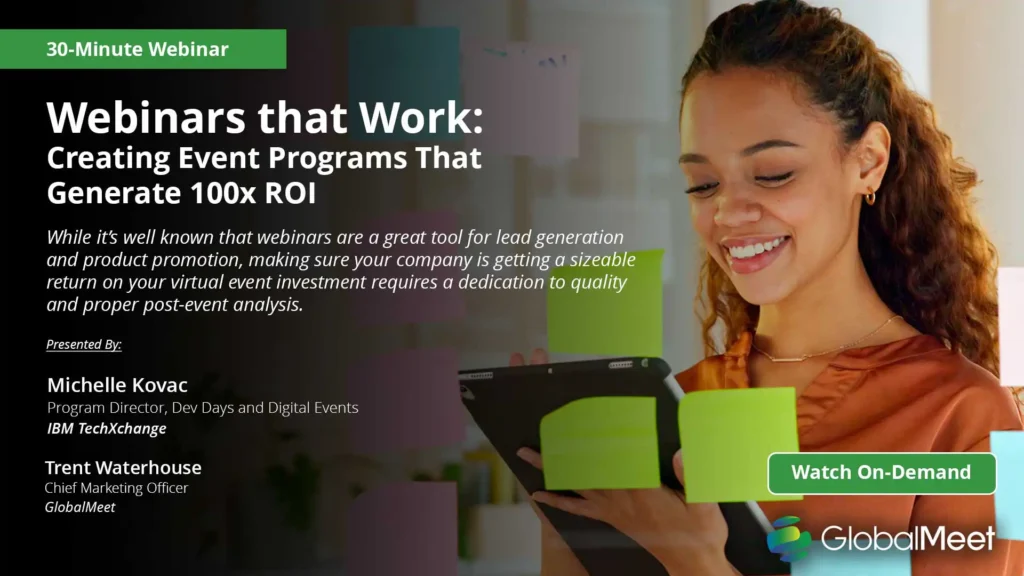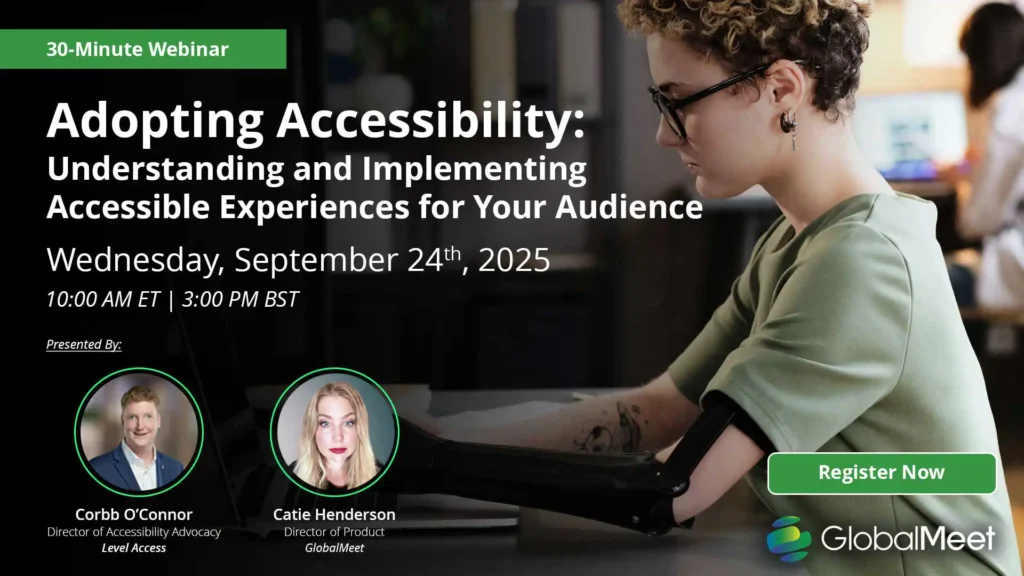
Best Practices for Improving Virtual Event Engagement
- by GlobalMeet Blog Team
- ,
Virtual events have become an essential part of many organizations strategies to connect with their audiences. However, keeping participants engaged during these events can be challenging. Simply hosting a webinar or virtual meeting is not enough; the key to success lies in fostering meaningful engagement with your attendees throughout the event.
To make your virtual events stand out and create a lasting impact, it’s crucial to integrate interactive elements that hold your audience’s attention and encourage participation. Implementing these best practices for improving virtual event engagement — from creative event engagement ideas to effective use of technology — can help you foster more dynamic, memorable, and impactful virtual experiences.
Survey and Poll Participants Periodically Throughout Your Event
One of the easiest ways to engage your virtual audience is by surveying and polling them periodically during the event. Polls and surveys provide real-time feedback, helping participants feel more involved in the session. These engagement tools not only capture valuable audience insights, but also break up the monotony of long presentations, encouraging attendees to stay actively engaged.
Polls and surveys can be used at the beginning of the event to gauge attendees’ knowledge or expectations, and throughout the event to measure understanding and engagement. Toward the end of the event, they can also serve to gather feedback on the event’s content, the speaker’s delivery, and overall experience.
For example, consider using polls to ask questions like:
- “What topics are you most excited to explore today?”
- “Which aspect of today’s presentation did you find most valuable?”
- “What additional resources would you like to receive after the event?”
By making these surveys anonymous, attendees may feel more comfortable providing honest answers. Moreover, analyzing these results can give you valuable insights that can then be used to improve future events.
Encourage Mid-Event Q&A and Knowledge Checks
Rather than waiting until the end of your virtual event to open the floor for questions, encourage Q&A sessions during the event. Mid-event Q&As offer attendees an opportunity to clarify doubts or explore certain points in more depth, increasing their understanding of the subject matter.
Implementing knowledge checks can also enhance virtual event engagement. These checks could take the form of quizzes, where participants are asked questions related to the presentation. Knowledge checks not only reinforce key points, but also provide an interactive element that breaks up the flow of the event. Attendees will feel more compelled to stay focused, knowing that they might be asked to engage with the material in real-time.
If you’re hosting a large virtual event, you might also consider using breakout rooms where smaller groups of attendees can discuss key topics and pose questions in a more intimate setting. Breakout rooms foster a sense of community and connection among participants, helping build engagement during the event.
Showcase Pre-recorded Videos in Addition to Your Slide Deck
Virtual events can sometimes fall into the trap of becoming one-dimensional, with presenters delivering long lectures while attendees passively watch slide decks. To add some variety and maintain attendee interest, consider incorporating pre-recorded videos into your presentations.
Pre-recorded videos allow you to showcase content in a dynamic way that breaks away from the traditional presentation format. Whether it’s a case study, an interview with a thought leader, or an instructional video, integrating this multimedia content can make your event feel more interactive and visually stimulating.
For example, if you’re presenting a new product, a pre-recorded demo video might be more engaging than static slides. These videos give participants a more immersive experience while allowing presenters to focus on answering questions and expanding on key points.
Incorporating pre-recorded videos also helps ensure smooth transitions between different sections of your presentation, reducing the risk of technical glitches that can happen during live presentations. Just be sure to keep the videos short and relevant to avoid losing participants’ attention altogether.
Allow Select Attendees to Be Featured Alongside Presenters on Screen
Virtual events are often one-way communication streams where presenters speak to an audience without much interaction. To make the experience more engaging, consider featuring select attendees on-screen alongside presenters. This can create a more personal and interactive experience, fostering a greater sense of involvement.
By inviting audience members to participate, you create opportunities for discussion, feedback, and collaborative learning. This strategy is particularly effective for smaller virtual events where the focus is on discussion and dialogue. You can select attendees based on their expertise, contribution in the chat, or prior involvement with the topic.
For example, during a panel discussion, you might invite participants to share their insights, ask questions directly, or provide testimonials. This creates a conversational dynamic that keeps the event from feeling too lecture-based and gives participants the chance to see themselves as contributors, rather than passive listeners.
This method also works well for virtual networking events, where participants can engage in one-on-one or small group discussions with the speakers and fellow attendees.
Offer CPE Credits to Incentivize Participation
Continuing Professional Education (CPE) credits are a powerful way to incentivize attendance and participation in virtual events. Offering CPE credits ensures that participants feel they are getting something valuable out of attending the event beyond just the information presented.
For professionals in industries such as accounting, finance, education, or law, CPE credits are essential to maintaining their credentials. By offering these credits, you not only encourage attendance but also engagement. Attendees are more likely to participate in polls, knowledge checks, and Q&A sessions if they know that these activities are tied to receiving CPE credits.
To ensure that you meet the standards for awarding CPE credits, make sure your content aligns with the requirements set forth by the appropriate governing body. Additionally, track attendance, participation, and engagement data so that you can verify that the requirements for awarding credits have been met.
Utilize a Virtual Event Platform that Captures Event Metrics
To improve virtual event engagement, it’s essential to have a platform that captures event metrics and provides insight into how attendees are interacting with your content. These metrics allow you to understand what worked well, what didn’t, and how you can adjust your strategy for future events.
A robust virtual event platform will track metrics such as:
- Audience retention rate
- Peak engagement times
- Poll and survey participation
- Q&A participation
- Breakout room activity
- Downloaded materials and shared links
With this data in hand, you can create more effective post-event collateral, such as follow-up emails, downloadable resources, and on-demand event recordings. Moreover, analyzing metrics like audience engagement levels and feedback can help you tailor future events to better suit the needs and preferences of your target audience.
For example, if you notice a dip in engagement during specific segments of your event, you might experiment with shorter presentations, more interactive elements, or a change in content format.
Conclusion
Improving virtual event engagement is not just about keeping your audience entertained, but creating opportunities for meaningful interaction and participation. By leveraging polls, Q&A sessions, pre-recorded videos, and featuring select attendees alongside presenters, you can transform a passive viewing experience into an active and dynamic event.
By incorporating these best practices, you can ensure that your virtual events stand out, engage participants, and leave a lasting impression.


